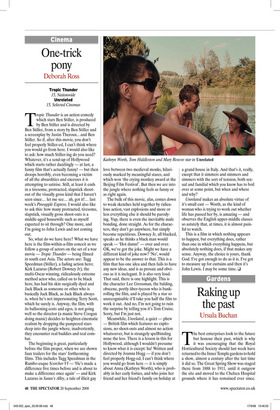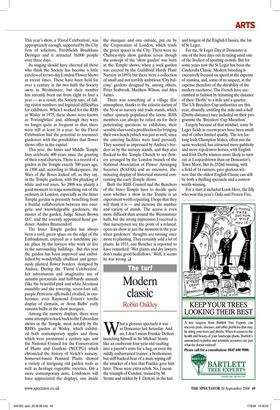Raking up the past
Ursula Buchan
The best enterprises look to the future but honour their past, which is why it was encouraging that the Royal Horticultural Society should last week have returned to the Inner Temple gardens to hold a show, almost a century after the last time it did so. The Great Spring Show was staged there from 1888 to 1911, until it outgrew the site and moved to the Chelsea Hospital grounds where it has remained ever since. This year’s show, a ‘Floral Celebration’, was appropriately enough, supported by the City firm of solicitors, Freshfields Bruckhaus Deringer and it attracted 16,000 people over three days.
Its staging should have cheered all those who think the Society has become a little careless of its two-day London Flower Shows in recent times. These have been held for over a century in the two halls the Society owns in Westminster, but their number has recently been cut from eight to four a year — as a result, the Society says, of falling visitor numbers and logistical difficulties for exhibitors. When I worked for the RHS at Wisley in 1975, these shows were known as ‘Fortnightlies’ and, although they were no longer quite as frequent as that, there were still at least 16 a year. So the Floral Celebration had the potential to reconnect gardeners with the possibilities that flower shows offer in the capital.
This year, the Inner and Middle Temple Inns celebrate 400 years since the granting of their royal charters. There is a record of a garden in the Temple exactly 700 years ago, in 1308 and, according to Shakespeare, the Wars of the Roses kicked off, as they say, in the Temple gardens, with the plucking of white and red roses. So 2008 was plainly a good moment to stage something out of the ordinary in London, especially as the Inner Temple garden is presently benefiting from a fruitful collaboration between two energetic and knowledgeable gardeners, the master of the garden, Judge Simon Brown Q.C. and the recently appointed head gardener, Andrea Brunsendorf.
The Inner Temple garden has always been a cool, green space on the edge of the Embankment, enjoyed as a lunchtime picnic place by the lawyers who work or live in the surrounding buildings. But this year the garden has been improved and embellished by wonderfully ebullient and generously planted flower borders, designed by Andrea. During the ‘Floral Celebration’, her adventurous and imaginative use of autumn perennials and half-hardy annuals (like the beautiful pink and white Nicotiana mutabilis and the towering, seven-foot tall, purple Persicaria officinalis) rivalled, in exuberance, even Raymond Evison’s terrific display of clematis, or Avon Bulbs’ early autumn bulbs in the show marquee.
Among the nursery displays, there were some attempts to hark back to the Edwardian shows in the Temple, most notably by the RHS’s garden at Wisley, which exhibited both contemporary apples and those which were prominent a century ago, and the National Council for the Conservation of Plants and Gardens (NCCPG) which chronicled the history of Veitch’s nursery. Somerset-based Pennard Plants showed a variety of intriguing old garden tools as well as heritage vegetable varieties. On a more contemporary note, Londoners will have appreciated the displays, one inside the marquee and one outside, put on by the Corporation of London, which tends the green spaces in the City. There were no Chelsea-style show gardens (even though the concept of the ‘show garden’ was born at the Temple shows, when a rock garden was erected by the Guildford Hardy Plant Nursery in 1893) but there were a collection of small and not terribly ambitious ‘City balcony’ gardens designed by, among others, Peter Seabrook, Matthew Wilson, and Alex James.
There was something of a village fête atmosphere, thanks to the eclectic nature of the 50 or so nursery and trade stands, which rather sparsely populated the lawns. RHS members can always be relied on for their penetrating questions to exhibitors, their sensible shoes and a predilection for bringing their own lunch (which was just as well, since the catering facilities were hard pressed). They seemed as impressed by Andrea’s borders as by the nursery stands, and they also flocked to the Temple Church to see flowers arranged by the London branch of the National Association of Flower Arranging Societies (NAFAS) and an extensive, illuminating display of historical material concerning the early Temple shows.
Both the RHS Council and the Benchers of the Inner Temple have to decide quite soon whether a show in the Temple is an experiment worth repeating. I hope that they will think it is — and increase the number and variety of stands. The access is even more difficult than around the Westminster halls, but the strong impression I received is that nurserymen see the point of a relaxed, open-air show at just the moment in the year when gardeners’ thoughts are turning once more to planting. They certainly sold a lot of plants. In 1911, one Bencher is reported to have remarked: ‘Wet plants and dry lawyers don’t make good bedfellows.’ Well, it seems he was wrong. ❑











































































 Previous page
Previous page